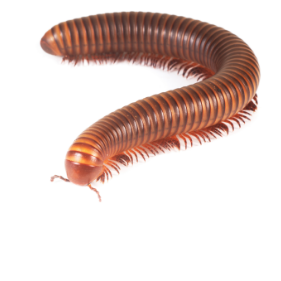Millipedes vs. Centipedes: How to Tell the Difference
As fellow many-legged creepy-crawlies, centipedes and millipedes are frequently confused with each other. There are a few things you can use to tell them apart, though:
- Number of legs. Centipedes have fewer legs than millipedes, and they tend to be longer. Millipedes have two pairs of legs per body segment; centipedes only have one.
- Body shape. Millipedes have rounded bodies and their legs are shorter, fitting underneath their bodies. Centipedes have flattened bodies with legs that stick out to the side.
- Movement speed. Millipedes move much more slowly than centipedes. They’re in no hurry.
- Diet. Millipedes are detritivores, which means they eat decaying plants and animals. Centipedes are omnivorous.
Signs of a Millipede Infestation
Millipedes commonly shelter under boxes or other storage material. You may find them after moving packaging material, especially in dark or quiet parts of your home or business. Millipedes require moisture to survive and will dry out and become “desiccated” if they don’t get enough. Desiccated millipede bodies may flake or fall apart, leaving behind crusty remains
Millipedes may secrete a foul-smelling liquid when threatened or crushed. This liquid may stain nearby fabrics such as carpeting. These stains will be small, vaguely circular, and yellow or brown.
Millipede Control and Prevention
Check for millipedes beneath storage materials in basements, crawl spaces, warehouses, and attics. Vacuum up any millipedes you encounter and dispose of the bag when finished. After removing millipedes, clear clutter to deprive millipedes of shelter. Manage waste diligently to control millipede’s food sources.
If millipedes live in your building for several weeks or more, then your building is probably too humid. Look for and fix causes of excess humidity. Patch up gaps, repair plumbing leaks, and make sure your ventilation and drainage work properly. Consider investing in dehumidifiers if the problem persists.
Millipede Behavior and Diet
Millipedes feed on decaying organic matter and are considered important natural recyclers. Millipedes live as close to reliable food sources as possible. They commonly infest rotting wood and actively seek out fungal growth. Millipedes thrive in dark, moist environments where they can access food. They may also burrow under soil to access rotting root systems.
Millipedes are very sensitive to temperature and humidity changes. They often migrate in large numbers during particularly wet or dry times. Millipedes move indoors to remain in dark, humid environments. Millipedes also move further from their usual places during spring and fall. During these seasons they may climb surfaces up to 6 feet off the ground.
Millipede Reproduction and Life Cycle
Millipedes undergo a three-stage developmental cycle consisting of “egg,” “nymph,” and “adult” stages. Millipedes start mating in early spring, but they can continue mating and laying eggs until temperatures begin to cool in the early fall.
Millipede nymphs look like adults but with fewer legs and body segments. Nymphs eat rotting material continuously to keep growing and must shed their skin several times. Nymphs may not develop into fully-grown millipedes for up to two years. Millipedes may live for an additional 8 years after reaching adulthood.
Count on Assured Environments for Expert Millipede Control Service
If you need help identifying millipedes and stopping them from getting into your building, contact Assured Environments. Our team has decades of experience handling pest infestations of all sizes. Since the presence of millipedes usually indicates that there’s another underlying pest problem, we’ll conduct a thorough inspection to get to the bottom of the problem.
Give us a call to get started with a free inspection!


